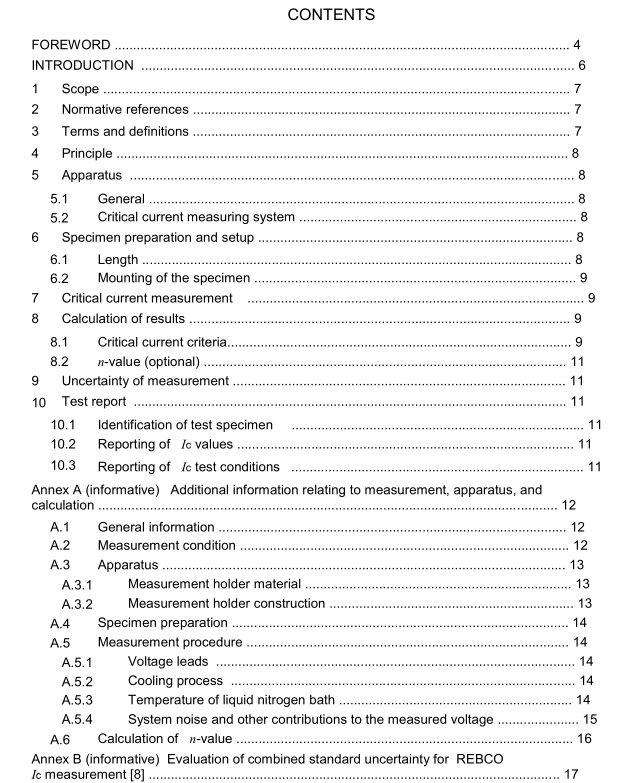IEC 61788-26 pdf – Superconductivity – Part 26: Critical current measurement – DC critical current of RE-Ba-Cu-O composite superconductors

IEC 61788-26 pdf – Superconductivity – Part 26: Critical current measurement – DC critical current of RE-Ba-Cu-O composite superconductors
This part of lEC 61788 specifies a test method for determining the DC critical current of shortRE(rare earth)-Ba-Cu-O(REBCO) composite superconductor specimens that have a shape ofstraight flat tape.This document applies to test specimens shorter than 300 mm and having a
rectangular cross section with an area of 0,03 mm 2 to 7,2 mm 2, which corresponds to tapeswith width ranging from 1,0 mm to 12,0 mm and thickness from 0,03 mm to 0,6 mm.
This method is intended for use with superconductor specimens that have critical current less
than 300 A and n-values larger than 5 under standard test conditions: the test specimen isimmersed in liquid nitrogen bath at ambient pressure without external magnetic field during the
testing. Deviations from this test method that are allowed for routine tests and other specificrestrictions are given in this document.
2Normative references
The following documents are referred to in the text in such a way that some or all of their contentconstitutes requirements of this document.For dated references, only the edition cited applies.
For undated references, the latestedition of the referenced document(including anyamendments) applies.
IEC 60050-815,International Electrotechnical Vocabulary (IEV) – Part 815: Superconductivity
3Terms and definitions
For the purposes of this document, the terms and definitions given in lEC 60050-815 and thefollowing apply.
IsO and lEC maintain terminological databases for use in standardization at the following URLs:. IEC Electropedia: available at http://www.electropedia.orgl
.Iso Online browsing platform: available at http://www.iso.org/obpl
3.1
constant sweep rate method
U-l data acquisition method where a current is swept at a constant rate from zero to a currentabove lIc, and where the U-l data are acquired continuously or frequently
3.2
ramp-and-hold method
U-I data acquisition method where a current is swept in stages from zero to a current above
lc,
where the current is held for an appropriate amount of time at each stage, and where the
U-I
data are acquired continuously or frequently
4Principle
The critical current of a composite superconductor specimen shall be determined from avoltage-current ( U-I) characteristic measured in a liquid nitrogen bath at ambient pressure.To
get a U-l characteristic, a direct current is applied to the superconductor specimen and thevoltage generated along the specimen is measured.The current is increased from zero and the
U-l characteristic is recorded.The critical current shall be determined as the current at which a
specific electric field strength criterion (electric field criterion)( Ec) is reached.For any selectedEc, there shall be a corresponding voltage criterion(Ue) for a specified voltage tap separation.
5 Apparatus
5.1 General
The apparatus required for the present test method includes the critical current measuringsystem. Additional information relating to the apparatus is given in Annex A.
5.2Critical current measuring system
The apparatus to measure the U-I characteristic should consist of a specimen probe, an openbath and a U-I measurement system.
The specimen probe, which consists ofa specimen and a measurement holder,is inserted inthe open bath filed with liquid nitrogen.The’U-I measurement system consists of a DC currentsource and necessary data acquisition system,preamplifiers, filters or voltmeters,or acombination thereof. Suitable measurement holder materials are recommended in A.3.1.
A computer assisted data acquisition system is recommended.
6 specimen preparation and setup
6.1 Length
An example of a schematic view of measurement setup is shown in Figure 1.The length ( L) of specimen to be measured shall be defined as follows:
where
is the distance between the voltage taps;
is the length of the current contact;
is the shortest distance from a current contact to the neighbouring voltage tap;
is the width of a voltage tap.
W is the width of a specimen to be measured.
The larger the current-carrying capacity of the specimen, the larger shall be L 2 . L 2 shall be increased for a specimen that has a stainless steel or other high-resistivity material backing or jacket . For a measurement that needs the higher voltage sensitivity, L 1 shall be increased. For some practical values for L 1 through L 4 , see A.3.2.









